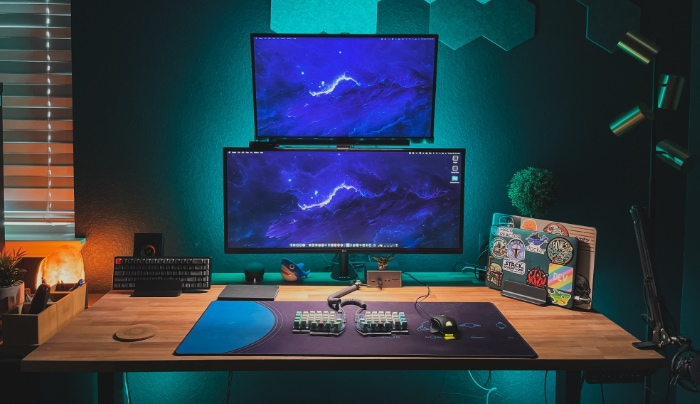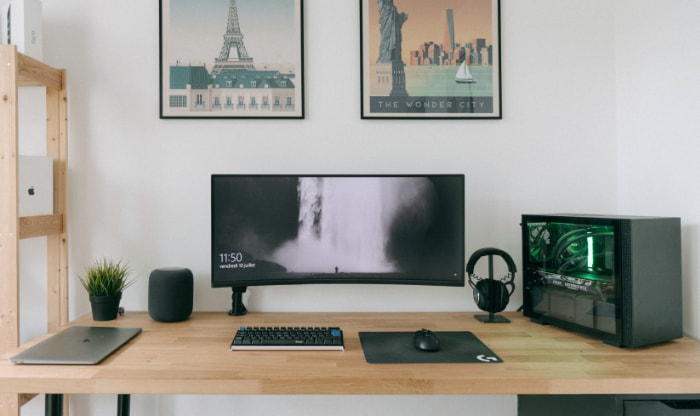144Hz vs. 165Hz Monitors: Enhancing Your Visual Play

Choosing the right monitor can significantly impact your gaming or professional visual experience. With technology constantly evolving, it's essential to understand how different monitor specifications can enhance your digital life.
Today, we're focusing on a key aspect that often sparks debates among tech enthusiasts: the refresh rate of monitors, specifically comparing 144Hz and 165Hz options. This topic is not just about numbers; it's about the fluidity of visuals on your screen and how it can affect everything from your gaming prowess to your daily computer usage.
Technical Breakdown: Understanding Hz in Monitors
Refresh rate, measured in Hertz (Hz), is a crucial feature of any monitor, greatly influencing your viewing experience. This concept is especially important in fast-paced environments like gaming or dynamic video editing.
Definition of Hertz (Hz) in the Context of Monitors
Hertz (Hz) in monitors refers to the number of times the display refreshes its image per second. Higher Hz rates mean more refresh cycles per second, resulting in smoother motion on the screen.
A monitor with a refresh rate of 144Hz refreshes the image 144 times per second, while a 165Hz monitor does so 165 times per second. This rapid updating reduces motion blur and creates a more fluid visual experience, which is particularly noticeable in fast-moving images.
Comparison of 144Hz and 165Hz in Technical Terms
When comparing 144Hz and 165Hz monitors, the difference lies in their ability to update the display image. While the jump from 144Hz to 165Hz may seem minor, it can be significant for high-level gaming where every millisecond counts.
The 165Hz monitors offer a slightly smoother image, which might be more noticeable to professional gamers or those sensitive to screen tearing and stuttering. However, for the average user, the difference might not be as evident, and other monitor features could be more important.
144Hz Monitors: Features and Advantages
144Hz monitors have become a standard in the gaming community and are also popular for general computer use. These monitors offer a significant upgrade from the traditional 60Hz displays, providing smoother visuals and enhanced gaming performance.
Overview of 144Hz Monitor Technology
The technology behind 144Hz monitors is designed to offer a smoother visual experience compared to standard monitors. By refreshing the screen 144 times per second, these monitors reduce motion blur and screen tearing, which is particularly noticeable in fast-paced games and videos.
This technology not only enhances gaming performance but also improves the overall quality of dynamic visual content.
Ideal Use Cases for 144Hz Monitors
144Hz monitors are particularly beneficial for gamers, especially those who play fast-paced or competitive games. The smoother motion provided by the higher refresh rate can give gamers a slight edge in reaction times.
These monitors are also suitable for professionals who work with video and animation, as the higher refresh rate ensures a more accurate and fluid playback.
Pros and Cons of Opting for a 144Hz Monitor
The main advantage of 144Hz monitors is the significantly improved visual fluidity over standard 60Hz monitors. This improvement enhances not just gaming but also general computer use, making for a more pleasant and less straining visual experience.
However, there are some considerations to keep in mind. First, to fully benefit from a 144Hz monitor, you need a computer capable of pushing the corresponding frame rates.
Also, these monitors can be more expensive than their 60Hz counterparts, and the difference in visual quality might not be as noticeable for casual users or those who don't play fast-paced games.
165Hz Monitors: Enhancements and Benefits

165Hz monitors represent the next step in the evolution of high-refresh-rate display technology. Designed for those who seek the ultimate in smooth visuals, these monitors further reduce motion blur and screen tearing compared to 144Hz models.
Detailed Look at 165Hz Monitor Technology
165Hz monitors operate by refreshing the display 165 times per second, outpacing the already speedy 144Hz monitors. This increase in refresh rate results in an even smoother image, which can be critical in situations where every frame counts.
This technology is particularly beneficial in reducing ghosting and screen tearing, common issues in fast-moving visual content.
Situations Where a 165Hz Monitor Is Preferable
For professional gamers and enthusiasts, a 165Hz monitor can provide a competitive edge. In fast-paced games, the extra frames per second can make the difference in spotting an opponent or reacting to a situation.
These monitors are also excellent for professionals in video editing and animation, where precise motion representation is crucial.
Advantages and Potential Drawbacks of 165Hz Monitors
The primary advantage of a 165Hz monitor is its ability to provide ultra-smooth visuals, which enhances both gaming and professional applications. The reduced motion blur and improved response times create a more immersive and effective experience.
However, there are some considerations to be aware of. Similar to 144Hz monitors, to fully utilize a 165Hz monitor, your computer needs to be capable of running games or applications at high frame rates.
Moreover, these monitors tend to be more expensive, and the perceptual difference between 144Hz and 165Hz might not be significant for all users. It's essential to weigh these factors against your specific needs and budget.
Performance Comparison: 144Hz vs. 165Hz
When deciding between a 144Hz and a 165Hz monitor, understanding how their performance compares in real-world scenarios is crucial. Both offer high refresh rates, but their subtle differences can impact user experience differently, depending on the specific use case.
Response Times and Gaming Performance
In the world of gaming, response time and refresh rate are critical for a seamless experience. Both 144Hz and 165Hz monitors offer quick response times, which is essential for fast-paced games.
However, the 165Hz monitor provides a marginally smoother experience due to its higher refresh rate. This difference can be particularly noticeable in competitive gaming, where even the slightest delay can impact performance.
Image Quality and Viewer Experience
The jump from 144Hz to 165Hz also influences overall image quality. While the difference may not be immediately apparent to casual users, it becomes more noticeable in scenarios involving rapid motion.
The higher refresh rate of 165Hz monitors results in less motion blur, making them a preferred choice for high-speed gaming or dynamic video content. For general use or slower-paced games, however, the difference might be less significant.
Compatibility with Graphics Cards and Gaming Consoles
A key factor in the performance of 144Hz and 165Hz monitors is their compatibility with your system's graphics card and gaming consoles. Higher refresh rates require more from your hardware.
While most modern graphics cards can easily support 144Hz, pushing them to 165Hz might require more power. It's essential to ensure that your system can fully utilize the capabilities of a 165Hz monitor to justify the investment.
Similarly, not all gaming consoles support these higher refresh rates, so it's worth checking compatibility before making a decision.
Price Consideration and Market Trends
The decision between a 144Hz and a 165Hz monitor often comes down to not just performance, but also cost and market availability. With technology advancing rapidly, the pricing and trends in the monitor market are constantly changing.
Price Comparison of 144Hz and 165Hz Monitors
Generally, 165Hz monitors are priced higher than their 144Hz counterparts. The price difference can vary based on brand, screen size, and additional features like panel type and resolution.
It's important to consider whether the smoother experience of a 165Hz monitor justifies the extra cost, especially if you're on a budget. For many users, particularly those not engaged in high-level competitive gaming, a 144Hz monitor might offer the best balance between cost and performance.
Current Market Trends for High-Refresh-Rate Monitors
The demand for high-refresh-rate monitors has been growing, driven by the increasing popularity of gaming and the rise in home office setups. This demand has led to a wider variety of models and features, from curved screens to ultra-wide formats.
As technology advances, the cost of both 144Hz and 165Hz monitors is gradually decreasing, making them more accessible to a broader audience. Additionally, new technologies are emerging, like OLED and QLED displays, which could influence future market trends and pricing.
Investment Value: Balancing Cost and Performance Benefits
When considering a high-refresh-rate monitor, it's important to evaluate the investment value. This involves balancing the cost against the performance benefits you'll receive.
For avid gamers or professionals in fields like video editing, the investment in a 165Hz monitor might be justifiable due to the smoother performance.
Conclusion
Deciding between a 144Hz and a 165Hz monitor hinges on several factors, including your specific needs, the type of content you frequently engage with, and budget considerations. Both refresh rates offer significant improvements over traditional 60Hz displays, bringing smoother visuals and enhanced performance, particularly in fast-paced environments.
For serious gamers and professionals in dynamic fields like video editing, the slight edge in fluidity that 165Hz monitors provide might be worth the investment. However, for many users, especially those not engaged in competitive gaming or high-speed video work, a 144Hz monitor presents a cost-effective solution without sacrificing much in terms of quality.
With the rapid advancement in display technology and changing market trends, it’s essential to weigh these factors carefully to choose a monitor that not only fits your current requirements but also offers lasting value. Remember, the best choice is one that aligns seamlessly with both your performance needs and budget.


